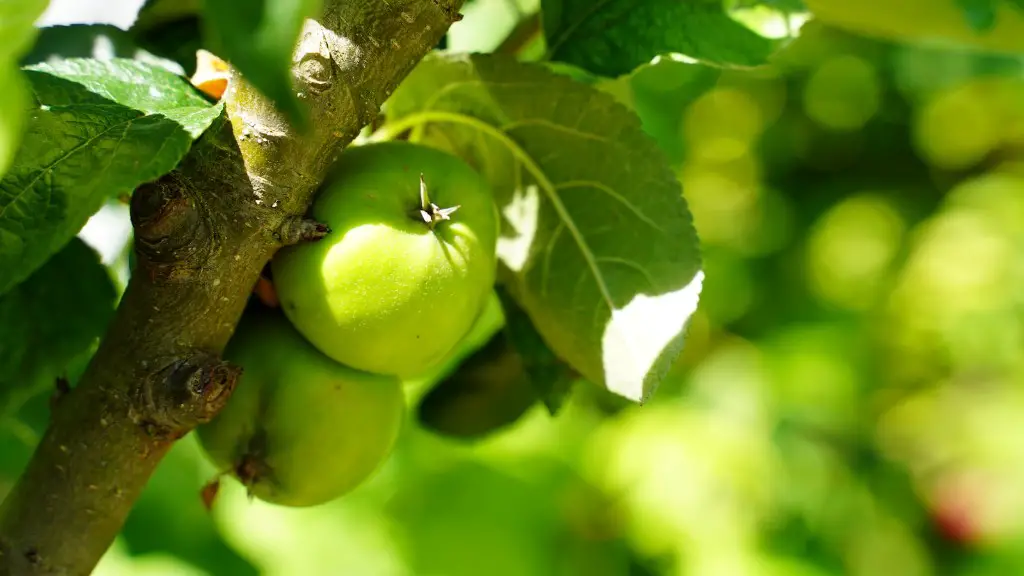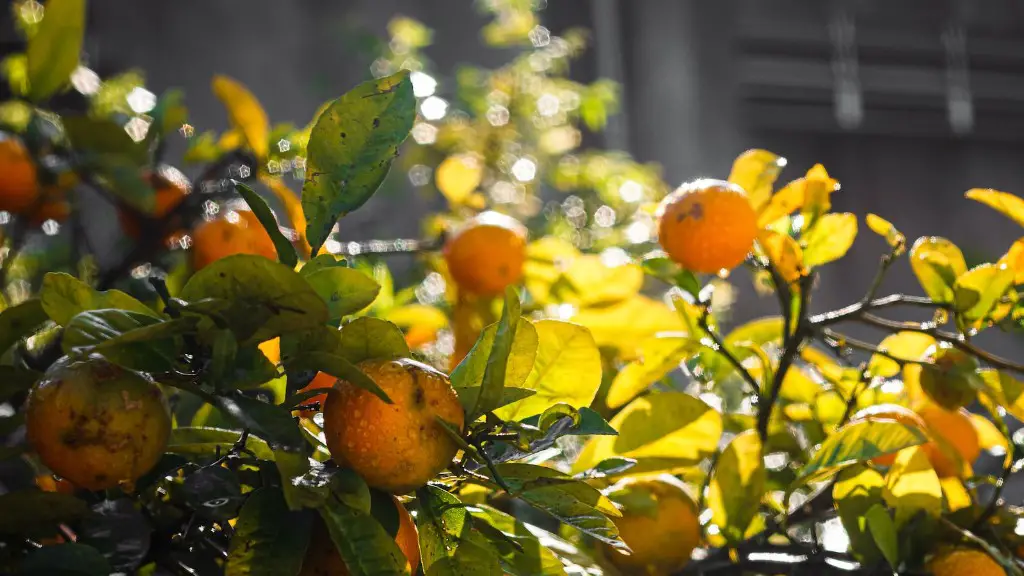Bug infestations can cause significant damage to apple trees. Fortunately, there are several strategies for managing and killing these insects. It’s important to identify the insect before attempting to eliminate it, as different bugs require different strategies for control. Here are some techniques for killing bugs on apple trees:
1. Prune the tree. Regular pruning can help eliminate insect infestations. Pruning reduces the number of potential hosts for an insect to feed on, so it’s an effective strategy for removing an infestation. Pruning is also a good practice for keeping the tree healthy and vigorous, helping it to recover from an insect attack more quickly.
2. Use insecticides. Insecticides are specifically designed to kill insects. These products can be sprayed directly onto the leaves or bark of the tree, or they can be applied to the soil around the tree to control root-feeding pests. Insecticides can be effective, but they should always be used as a last resort, and only when all other actions are unsuccessful.
3. Attract beneficial insects. Some beneficial insects, such as ladybugs, lacewings, and parasitic wasps, prevent infestations by preying on certain destructive bugs. Attracting these beneficial insects can help keep populations of harmful insects in check. Planting flowering plants that attract beneficial insects is one of the best ways to control pests.
4. Use organic, natural sprays. Natural, organic sprays can be used as an alternative to chemical insecticides. Neem oil and horticultural oils are two of the most commonly used natural sprays. These oils act as smothering agents that can help to smother and kill insects without introducing new chemicals into the environment.
5. Practice proper sanitation. Keeping the area around the tree clean can help reduce infestations by removing potential food sources and habitats for bugs. Mulching and removing debris from around the tree can help remove hiding and breeding places for pests. Sanitation can also help reduce competition for resources between beneficial and harmful insects.
6. Introduce beneficial nematodes or bacteria. Beneficial nematodes and bacteria can be effective in controlling certain types of insect pests. Nematodes feed on insect larvae, and can be released into the soil around the tree. Bacteria, such as Bacillus thuringiensis, can be applied to the tree to kill the larvae of certain insects.
7. Use sticky traps. Sticky traps are simple and effective ways to monitor and reduce infestations of certain types of insect pests. These traps attract the insects and trap them so they cannot infest the tree. Sticky traps should be placed around the tree, ensuring that all sides are covered.
Organic Sprays
Organic sprays are an effective and safe way to control pests on apple trees. Neem oil and horticultural oils are both organic sprays that can be used to control pests and disease. Neem oil acts as an insect growth regulator, preventing insects from maturing and reproducing. Horticultural oil works by forming a thin layer across the surface of the plant, making it difficult for pests and diseases to penetrate the underlying tissue. Both of these products are safe for humans, and can be used as alternatives to chemical insecticides.
Organic sprays must be applied correctly in order to be effective. The oil must be applied directly to the surfaces of the tree, including the leaves, flowers, and bark. Additionally, the spraying must be done on a day when the winds are calm and rain is not expected for at least 24 hours. When applying the organic spray, be sure to completely cover the entire tree, as insects can hide in the nooks and crannies.
Organic sprays are effective for preventing and controlling infestations of certain pests. Additionally, they are safe for humans, and have no long-term negative effects on the environment. For these reasons, organic sprays are preferred over chemical insecticides for controlling pests on apple trees.
Ladybugs and Lacewings
Ladybugs and lacewings are two beneficial insects that are frequently used to control pests on apple trees. Ladybugs feed on a variety of soft-bodied pests, such as aphids, mealybugs, and whiteflies. Lacewings feed on both soft-bodied insects, as well as larger insects, such as caterpillars and grubs. Both ladybugs and lacewings are effective in controlling insect populations and minimizing the damage caused.
Attracting ladybugs and lacewings to apple trees is relatively easy. Providing a habitat for these insects is the best way to ensure that they remain in the area. Flowers, such as alyssum, whose blooms attract these beneficial insects, should be planted around the tree. Other plants, such as dill, can also be used to attract these insects. Additionally, providing a water source, such as a shallow dish filled with stones, can help keep these beneficial insects in the area.
Ladybugs and lacewings can be an effective form of pest control for apple trees. By providing an ideal habitat and water source, these beneficial insects can be encouraged to stay in the area and keep the insect populations in check. This is an excellent form of prevention, as it does not introduce any chemicals into the environment.
Bacillus Thuringiensis
Bacillus thuringiensis (BT) is a bacteria that can be used to control certain types of pests on apple trees. BT is effective against a wide variety of insect pests, including beetles, moths, and caterpillars. The bacteria is applied to the tree as a spray, and it is ingested by the pests. Once inside the insect’s digestive system, the bacteria produces a toxin, killing the pest. BT is considered a safe, non-toxic solution, as it will not harm beneficial insects or other animals.
When preparing to apply BT to an apple tree, it is important to correctly identify the pest first. This is because different pest species require different BT formulations. Once the correct formulation is determined, the spray should be applied directly to the foliage, flowers, and bark of the tree, covering all sides completely. It should also be applied in the late afternoon or evening, when temperatures are cooler and the wind is low. Additionally, the bacteria should be reapplied every two weeks until the pest is eliminated.
Bacillus thuringiensis is an effective way to control certain pests on apple trees. It is important to correctly identify the pests first, as different pests require different formulations of the bacteria. Once the correct formulation is applied, BT can be effective in killing the pests without introducing harmful chemicals into the environment.
Mulching and Sanitation
Mulching and sanitation are essential strategies for reducing pest infestations on apple trees. Mulching can provide many benefits for the tree, such as helping to control weeds, retain moisture, and improve soil structure. While mulching can be beneficial, it can also provide an ideal habitat for certain pests. Therefore, the mulch should be spread around the tree, but kept away from the trunk and roots. Additionally, any debris and fallen fruit should be removed from around the tree, as these provide food sources and habitat for insects.
Sanitation is also important for reducing pest infestations. Keeping the area around the tree free of debris, weeds, and fallen fruit eliminates potential breeding and hiding grounds for pests. Additionally, sanitation helps to reduce competition for resources between beneficial and harmful insects, making it easier for beneficial insects to do their job of controlling harmful pests.
Mulching and sanitation are important strategies for reducing pest infestations on apple trees. Mulch should be kept away from the trunk and roots, and any debris or fallen fruit should be removed from around the tree. Additionally, keeping the area clean eliminates potential hiding and breeding areas for pests, making it easier for beneficial insects to do their job of controlling harmful pests.
Sticky Traps and Insecticides
Sticky traps and insecticides are two of the most commonly used techniques for controlling pests on apple trees. Sticky traps are simple to use, and they can be effective in controlling certain types of insects. These traps should be placed around the tree, covering the entire area. When the traps become filled with insects, they should be removed and replaced with new traps.
Insecticides can also be effective in controlling insects. These products should be used as a last resort, and only when other methods are unsuccessful. When applying insecticides, always read the label and follow all instructions. Additionally, use the least toxic product possible, and use it only in the amounts recommended.
Sticky traps and insecticides can be effective in controlling pests on apple trees. Traps should be placed around the entire tree, and insecticides should be used as a last resort, when other methods are unsuccessful. When using insecticides, always read and follow all instructions, and use the least toxic product available.



